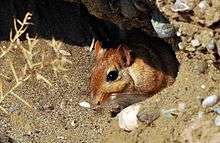Tristram's jird
| Tristram's jird | |
|---|---|
 | |
| Scientific classification | |
| Kingdom: | Animalia |
| Phylum: | Chordata |
| Class: | Mammalia |
| Order: | Rodentia |
| Family: | Muridae |
| Genus: | Meriones |
| Subgenus: | Pallasiomys |
| Species: | M. tristrami |
| Binomial name | |
| Meriones tristrami Thomas, 1892 [2] | |
| Synonyms [3] | |
| |
Meriones tristrami, known as Tristram's jird, is a species of gerbil that lives in the Middle East. It is named after the Reverend Henry Baker Tristram who collected the first specimens. It is up to 155 mm (6.1 in) long, and lives in burrows in steppes and semi-deserts from Turkey and the Caucasus to Israel and Iran. Records from the Greek island of Kos represent the only gerbils reported from Europe, outside the former Soviet Union. It is a common, widespread species, and is not considered to be threatened.
Description
Meriones tristrami reaches a total length (excluding the tail) of 100–155 millimetres (3.9–6.1 in), with a skull around 32–40 mm (1.3–1.6 in) long.[4] Its fur is "dark yellowish-brown" on its back, "yellowish orange" on its sides, and white on the belly.[5] The soles of its hind feet are hairless at the heels, and it has a much smaller auditory bulla than the other jirds that occur in the same region.[4] The tail is bi-colored, and ends in an inconpicuous black tuft, about one quarter of the length of the tail.[5]
Distribution and ecology
Meriones tristrami is found from Turkey in the west, to the Caucasus (Armenia, Azerbaijan), and south through Iraq, Syria, Lebanon and Israel to Jordan and Iran. It has also been recorded from the Greek island of Kos, although it has not been seen there for more than a decade.[1] The records of M. tristrami from Kos are the only reports of a gerbil from a European country (excluding the former Soviet Union), or from an island in the eastern Mediterranean Sea.[6] Fossil evidence, however, shows that it has lived in the southern Levant for at least 160,000 years.[3]
It lives in semi-deserts and steppes, and is supposedly limited to areas receiving an annual total precipitation of at least 100 millimetres (3.9 in). It feeds on various seeds and leaves, but although it lives in burrows, it does not store any food there.[1]
Taxonomy
Meriones tristrami was first described by Oldfield Thomas in 1892.[3] He based his description on type material from the Dead Sea region of Israel collected by "Canon H. B. Tristram" (Henry Baker Tristram), who is commemorated in the specific epithet tristrami.[2] It is classified in the subgenus Pallasiomys of the gerbil genus Meriones, and its members have sometimes been included within the species Meriones shawi.[3]
A number of subspecies have been described within M. tristrami, but the genetic differences between them are slight,[7] and no subspecies are recognised in Mammal Species of the World.[3]
Conservation
Meriones tristrami has a wide geographical range, including many protected areas, and has no serious threats. It is therefore listed as being of Least Concern on the IUCN Red List.[1]
References
| Wikispecies has information related to: Meriones tristrami |
- 1 2 3 4 M. Sozen; A. Bukhnikashvili; G. Shenbrot; D. Scott; G. Amori; B. Kryštufek; N. Yigit & G. Mitsain (2008). "Meriones tristrami". IUCN Red List of Threatened Species. Version 2011.2. International Union for Conservation of Nature. Retrieved April 30, 2012.
- 1 2 Oldfield Thomas (1892). "Description of a new Species of Meriones from Palestine". Annals and Magazine of Natural History. 6th series. 9: 148–149. doi:10.1080/00222939208677293.
- 1 2 3 4 5 Guy G. Musser & Michael D. Carleton (2005). "Meriones (Pallasiomys) tristrami". In Don E. Wilson & DeeAnn M. Reeder. Mammal Species of the World: a Taxonomic and Geographic Reference. 2 (3rd ed.). Baltimore, Maryland: Johns Hopkins University Press. p. 1239. ISBN 978-0-8018-8221-0. OCLC 62265494.
- 1 2 Mazin B. Qumsiyeh (1996). "Rodents". Mammals of the Holy Land. Texas Tech University Press. pp. 224–313. ISBN 978-0-89672-364-1.
- 1 2 Richard Hoath (2009). "Plate 26: The Jirds". A Field Guide to the Mammals of Egypt. American University in Cairo Press. ISBN 978-977-416-254-1.
- ↑ Jochen Niethammer (1989). "Gewöllinhalte der Schleiereule (Tyto alba) von Kos und aus Südwestanatolien" [Pellet contents of Barn Owls (Tyto alba) in Kos and south-western Anatolia] (PDF). Bonner Zoologische Beiträge (in German). 40 (1): 1–9.
- ↑ Şafak Bulut & Nuri Yiğit (2011). "Allozyme variations on subspecies of Meriones tristrami (Rodentia: Gerbillinae) in Western Anatolia" (PDF). Hacettepe Journal of Biology and Chemistry. 39 (1): 51–56.
